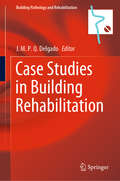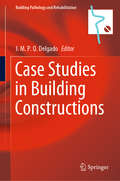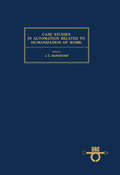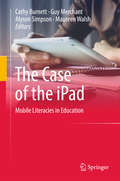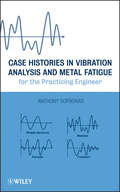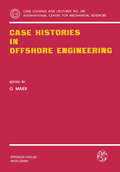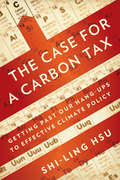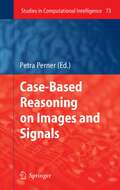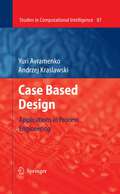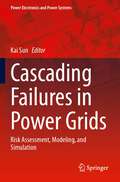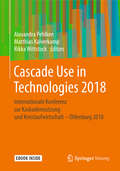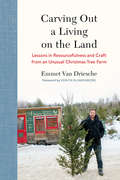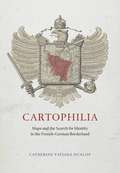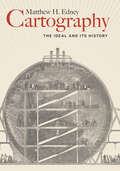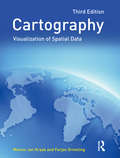- Table View
- List View
Case Studies in Building Rehabilitation (Building Pathology and Rehabilitation #13)
by J. M. P. Q. DelgadoThe book presents recent research and practical insights relating to building pathology. As such it contributes toward the systematization and dissemination of knowledge regarding structural and hygrothermal pathologies, durability and diagnostic techniques, while at the same time, demonstrating the latest advances in this domain. It includes new developments in the field of building pathology and rehabilitation, bridging the gap between current approaches to the surveying of buildings and the detailed study of defect diagnosis, prognosis and remediation. It also features a number of case studies and a detailed list of references and suggestions for further reading. Providing an overview of the current state of the art in the field, the book will appeal to scientists, students, practitioners and lecturers. Furthermore, the topics covered are relevant to a variety of scientific and engineering disciplines, including civil, materials and mechanical engineering.
Case Studies in Building Constructions (Building Pathology and Rehabilitation #15)
by J. M. P. Q. DelgadoThe book presents recent research and a collection of case studies and real-world experiences relating to building construction. Covering building rehabilitation, building diagnostics, service-life prediction and life-cycles, and hygrothermal behaviour, it bridges the gap between current approaches to the surveying of buildings and the detailed study of defect diagnosis, prognosis and remediation. The book features several case studies on building pathologies as well as a detailed set of references and suggestions for further reading. Offering a systematic review of the current state of knowledge, it is a valuable resource for scientists, students, practitioners, and lecturers in various scientific and engineering disciplines, including civil and materials engineering, as well as and other interested parties.
Case Studies in Automation Related to Humanization of Work: Proceedings of the IFAC Workshop, Enschede, Netherlands, 31 October - 4 November 1977
by J. E. RijnsdorpCase Studies in Automation Related to Humanization of Work focuses on the role of organization renewal in the humanization of work, including the effects of automation on the industries and workers. The selection first offers information on the quality of working life and work of the social effects of automation committee from Bad Boll to Enschede. Topics include factors and situations that foster or hinder diffusion of successful development in the QWL field and development of alienating work. The book also examines a comparative study in various man-machine systems; work organization with multipurpose assembly robots; and system development and human consequences in the steel industry. The text discusses man-machine interfaces in the Cony-16 integrated manufacturing system, automation of wig-welding, and mechanization of assembly lines in the automotive industry. The book also underscores an approach to the production line of automobiles by man-computer system, including stock minimization, problems of line balancing in assembly process, and production control and inventory. The publication is a dependable reference for readers wanting to study the relationship of automation and quality of work life.
The Case of the iPad: Mobile Literacies in Education
by Cathy Burnett Guy Merchant Alyson Simpson Maureen WalshThis book brings together an international group of literacy studies scholars who have investigated mobile literacies in a variety of educational settings. Approaching mobility from diverse theoretical perspectives, the book makes a significant contribution to how mobile literacies, and tablets in particular, are being conceptualised in literacy research. The book focuses on tablets, and particularly the iPad, as a prime example of mobile literacies, setting this within the broader context of literacy and mobility.The book provides inspiration and direction for future research in mobile literacies, based upon 16 chapters that investigate the relationship between tablets and literacy in diverse ways. Together they address the complex and multiple forces associated with the distribution of the technologies themselves and the texts they mediate, and consider how apps, adults and children work together as iPads enter the mesh of practices and material arrangements that constitute the institutional setting.
Case Histories in Vibration Analysis and Metal Fatigue for the Practicing Engineer
by Anthony SofronasThis highly accessible book provides analytical methods and guidelines for solving vibration problems in industrial plants and demonstrates their practical use through case histories from the author's personal experience in the mechanical engineering industry. It takes a simple, analytical approach to the subject, placing emphasis on practical applicability over theory, and covers both fixed and rotating equipment, as well as pressure vessels. It is an ideal guide for readers with diverse experience, ranging from undergraduate students to mechanics and professional engineers.
Case Histories in Vibration Analysis and Metal Fatigue for the Practicing Engineer
by Anthony SofronasThis highly accessible book provides analytical methods and guidelines for solving vibration problems in industrial plants and demonstrates their practical use through case histories from the author's personal experience in the mechanical engineering industry. It takes a simple, analytical approach to the subject, placing emphasis on practical applicability over theory, and covers both fixed and rotating equipment, as well as pressure vessels. It is an ideal guide for readers with diverse experience, ranging from undergraduate students to mechanics and professional engineers.
Case Histories in Offshore Engineering (CISM International Centre for Mechanical Sciences #283)
by G. MaierThe Case for a Carbon Tax: Getting Past Our Hang-Ups to Effective Climate Policy
by Shi-Ling HsuThere's a simple, straightforward way to cut carbon emissions-and we're rejecting it because of irrational political fears. That's the central argument of The Case for a Carbon Tax, a clear-eyed, sophisticated analysis of climate change policy.Shi-Ling Hsu weighs the merits of the four major approaches to curbing CO2: cap-and-trade; command and control regulation; government subsidies of alternative energy; and carbon taxes. He does not claim that a tax is the perfect or only solution-but that unlike the alternatives, it can be implemented immediately and paired effectively with other approaches.Hsu deftly explores the social and political factors that prevent us from embracing this commonsense approach. And he shows why we must get past our hang-ups if we are to avert a global crisis.
Case-Based Reasoning on Images and Signals (Studies in Computational Intelligence #73)
by Petra PernerThis is the first edited book that deals with the special topic of signals and images within Case-Based Reasoning (CBR). Signal-interpreting systems are becoming increasingly popular in medical, industrial, ecological, biotechnological and many other applications. Existing statistical and knowledge-based techniques lack robustness, accuracy and flexibility. New strategies are needed that can adapt to changing environmental conditions, signal variation, user needs and process requirements. Introducing CBR strategies into signal-interpreting systems can satisfy these requirements.
Case Based Design: Applications in Process Engineering (Studies in Computational Intelligence #87)
by Yuri Avramenko Andrzej KraslawskiIn a highly authoritative and systematic manner, this book offers an in-depth treatment of the essence of the case–based reasoning strategy and case-based design dwelling upon the algorithmic facet of the paradigm. It provides an excellent applied research framework by showing how this development can be effectively utilized in the real word complicated environment of process engineering, a pursuit that is rarely reported in the literature in such a comprehensive manner.
Cascading Failures in Power Grids: Risk Assessment, Modeling, and Simulation (Power Electronics and Power Systems)
by Kai SunCascading failures as long chains of events and outages are threats to reliable operations of power grids and can lead to catastrophic blackouts with tremendous losses if not understood, prevented, or mitigated sufficiently. This book provides an in-depth and comprehensive presentation of emerging methods for risk assessment, modeling, and simulation of cascading failures in power grids. The methods are all supported by theories and experimental tests using realistic power grid models and data, and the contributors to this volume are leading scholars in the field. Specific topics covered include an introduction to cascading failures, probabilistic analytics of utility outage data and risks, quantitative influence and interaction models to understand and mitigate failure propagation, simulation of cascading failures using models of multiple time scales, and industrial criteria and practices against cascading failures. Cascading Failures in Power Grids: Risk Assessment, Modeling, and Simulation will provide comprehensive and in-depth coverage of state-of-the-art methods for all readers interested in cascading failures and will inspire researchers and engineers to develop emerging and practical tools in the future.
Cascade Use in Technologies 2018: Internationale Konferenz zur Kaskadennutzung und Kreislaufwirtschaft – Oldenburg 2018
by Alexandra Pehlken Matthias Kalverkamp Rikka WittstockThe conference addresses general topics on how products and materials can be recycled and looks for application examples. The focus is on the areas:· Material and Energy Flow Assessment· Sustainable Mobility· Industrial Ecology with a focus on renewable energy sources or WEEE· (Re-) Manufacturing· Cascade Use and Waste Management 4.0
Carving Out a Living on the Land: Lessons in Resourcefulness and Craft from an Unusual Christmas Tree Farm
by Emmet Van DriescheWhen he first envisioned becoming a farmer, author Emmet Van Driesche never imagined his main crop would be Christmas trees, nor that such a tree farm could be more of a managed forest than the conventional grid of perfectly sheared trees. Carving Out a Living on the Land tells the story of how Van Driesche navigated changing life circumstances, took advantage of unexpected opportunities, and leveraged new and old skills to piece together an economically viable living, while at the same time respecting the land’s complex ecological relationships. From spoon carving to scything, coppicing to wreath-making, Carving Out a Living on the Land proves that you don’t need acres of expensive bottomland to start your land-based venture, but rather the creativity and vision to see what might be done with that rocky section or ditch or patch of trees too small to log. You can lease instead of buy; build flexible, temporary structures rather than sink money into permanent ones; and take over an existing operation rather than start from scratch. What matters are your unique circumstances, talents, and interests, which when combined with what the land is capable of producing, can create a fulfilling and meaningful farming life.
Cartophilia: Maps and the Search for Identity in the French-German Borderland
by Catherine Tatiana DunlopThe period between the French Revolution and World War II was a time of tremendous growth in both mapmaking and map reading throughout Europe. There is no better place to witness this rise of popular cartography than in Alsace-Lorraine, a disputed borderland that the French and Germans both claimed as their national territory. Desired for its prime geographical position and abundant natural resources, Alsace-Lorraine endured devastating wars from 1870 to 1945 that altered its borders four times, transforming its physical landscape and the political allegiances of its citizens. For the border population whose lives were turned upside down by the French-German conflict, maps became essential tools for finding a new sense of place and a new sense of identity in their changing national and regional communities. Turning to a previously undiscovered archive of popular maps, Cartophilia reveals Alsace-Lorraine’s lively world of citizen mapmakers that included linguists, ethnographers, schoolteachers, hikers, and priests. Together, this fresh group of mapmakers invented new genres of maps that framed French and German territory in original ways through experimental surveying techniques, orientations, scales, colors, and iconography. In focusing on the power of “bottom-up” maps to transform modern European identities, Cartophilia argues that the history of cartography must expand beyond the study of elite maps and shift its emphasis to the democratization of cartography in the modern world.
Cartophilia: Maps and the Search for Identity in the French-German Borderland
by Catherine Tatiana DunlopThe period between the French Revolution and World War II was a time of tremendous growth in both mapmaking and map reading throughout Europe. There is no better place to witness this rise of popular cartography than in Alsace-Lorraine, a disputed borderland that the French and Germans both claimed as their national territory. Desired for its prime geographical position and abundant natural resources, Alsace-Lorraine endured devastating wars from 1870 to 1945 that altered its borders four times, transforming its physical landscape and the political allegiances of its citizens. For the border population whose lives were turned upside down by the French-German conflict, maps became essential tools for finding a new sense of place and a new sense of identity in their changing national and regional communities. Turning to a previously undiscovered archive of popular maps, Cartophilia reveals Alsace-Lorraine’s lively world of citizen mapmakers that included linguists, ethnographers, schoolteachers, hikers, and priests. Together, this fresh group of mapmakers invented new genres of maps that framed French and German territory in original ways through experimental surveying techniques, orientations, scales, colors, and iconography. In focusing on the power of “bottom-up” maps to transform modern European identities, Cartophilia argues that the history of cartography must expand beyond the study of elite maps and shift its emphasis to the democratization of cartography in the modern world.
Cartophilia: Maps and the Search for Identity in the French-German Borderland
by Catherine Tatiana DunlopThe period between the French Revolution and World War II was a time of tremendous growth in both mapmaking and map reading throughout Europe. There is no better place to witness this rise of popular cartography than in Alsace-Lorraine, a disputed borderland that the French and Germans both claimed as their national territory. Desired for its prime geographical position and abundant natural resources, Alsace-Lorraine endured devastating wars from 1870 to 1945 that altered its borders four times, transforming its physical landscape and the political allegiances of its citizens. For the border population whose lives were turned upside down by the French-German conflict, maps became essential tools for finding a new sense of place and a new sense of identity in their changing national and regional communities. Turning to a previously undiscovered archive of popular maps, Cartophilia reveals Alsace-Lorraine’s lively world of citizen mapmakers that included linguists, ethnographers, schoolteachers, hikers, and priests. Together, this fresh group of mapmakers invented new genres of maps that framed French and German territory in original ways through experimental surveying techniques, orientations, scales, colors, and iconography. In focusing on the power of “bottom-up” maps to transform modern European identities, Cartophilia argues that the history of cartography must expand beyond the study of elite maps and shift its emphasis to the democratization of cartography in the modern world.
Cartophilia: Maps and the Search for Identity in the French-German Borderland
by Catherine Tatiana DunlopThe period between the French Revolution and World War II was a time of tremendous growth in both mapmaking and map reading throughout Europe. There is no better place to witness this rise of popular cartography than in Alsace-Lorraine, a disputed borderland that the French and Germans both claimed as their national territory. Desired for its prime geographical position and abundant natural resources, Alsace-Lorraine endured devastating wars from 1870 to 1945 that altered its borders four times, transforming its physical landscape and the political allegiances of its citizens. For the border population whose lives were turned upside down by the French-German conflict, maps became essential tools for finding a new sense of place and a new sense of identity in their changing national and regional communities. Turning to a previously undiscovered archive of popular maps, Cartophilia reveals Alsace-Lorraine’s lively world of citizen mapmakers that included linguists, ethnographers, schoolteachers, hikers, and priests. Together, this fresh group of mapmakers invented new genres of maps that framed French and German territory in original ways through experimental surveying techniques, orientations, scales, colors, and iconography. In focusing on the power of “bottom-up” maps to transform modern European identities, Cartophilia argues that the history of cartography must expand beyond the study of elite maps and shift its emphasis to the democratization of cartography in the modern world.
Cartography: The Ideal and Its History
by Matthew H. EdneyOver the past four decades, the volumes published in the landmark History of Cartography series have both chronicled and encouraged scholarship about maps and mapping practices across time and space. As the current director of the project that has produced these volumes, Matthew H. Edney has a unique vantage point for understanding what “cartography” has come to mean and include. In this book Edney disavows the term cartography, rejecting the notion that maps represent an undifferentiated category of objects for study. Rather than treating maps as a single, unified group, he argues, scholars need to take a processual approach that examines specific types of maps—sea charts versus thematic maps, for example—in the context of the unique circumstances of their production, circulation, and consumption. To illuminate this bold argument, Edney chronicles precisely how the ideal of cartography that has developed in the West since 1800 has gone astray. By exposing the flaws in this ideal, his book challenges everyone who studies maps and mapping practices to reexamine their approach to the topic. The study of cartography will never be the same.
Cartography: The Ideal and Its History (The\history Of Cartography Ser. #4)
by Matthew H. EdneyOver the past four decades, the volumes published in the landmark History of Cartography series have both chronicled and encouraged scholarship about maps and mapping practices across time and space. As the current director of the project that has produced these volumes, Matthew H. Edney has a unique vantage point for understanding what “cartography” has come to mean and include. In this book Edney disavows the term cartography, rejecting the notion that maps represent an undifferentiated category of objects for study. Rather than treating maps as a single, unified group, he argues, scholars need to take a processual approach that examines specific types of maps—sea charts versus thematic maps, for example—in the context of the unique circumstances of their production, circulation, and consumption. To illuminate this bold argument, Edney chronicles precisely how the ideal of cartography that has developed in the West since 1800 has gone astray. By exposing the flaws in this ideal, his book challenges everyone who studies maps and mapping practices to reexamine their approach to the topic. The study of cartography will never be the same.
Cartography: The Ideal and Its History
by Matthew H. EdneyOver the past four decades, the volumes published in the landmark History of Cartography series have both chronicled and encouraged scholarship about maps and mapping practices across time and space. As the current director of the project that has produced these volumes, Matthew H. Edney has a unique vantage point for understanding what “cartography” has come to mean and include. In this book Edney disavows the term cartography, rejecting the notion that maps represent an undifferentiated category of objects for study. Rather than treating maps as a single, unified group, he argues, scholars need to take a processual approach that examines specific types of maps—sea charts versus thematic maps, for example—in the context of the unique circumstances of their production, circulation, and consumption. To illuminate this bold argument, Edney chronicles precisely how the ideal of cartography that has developed in the West since 1800 has gone astray. By exposing the flaws in this ideal, his book challenges everyone who studies maps and mapping practices to reexamine their approach to the topic. The study of cartography will never be the same.
Cartography: The Ideal and Its History
by Matthew H. EdneyOver the past four decades, the volumes published in the landmark History of Cartography series have both chronicled and encouraged scholarship about maps and mapping practices across time and space. As the current director of the project that has produced these volumes, Matthew H. Edney has a unique vantage point for understanding what “cartography” has come to mean and include. In this book Edney disavows the term cartography, rejecting the notion that maps represent an undifferentiated category of objects for study. Rather than treating maps as a single, unified group, he argues, scholars need to take a processual approach that examines specific types of maps—sea charts versus thematic maps, for example—in the context of the unique circumstances of their production, circulation, and consumption. To illuminate this bold argument, Edney chronicles precisely how the ideal of cartography that has developed in the West since 1800 has gone astray. By exposing the flaws in this ideal, his book challenges everyone who studies maps and mapping practices to reexamine their approach to the topic. The study of cartography will never be the same.
Cartography: The Ideal and Its History (The\history Of Cartography Ser. #4)
by Matthew H. EdneyOver the past four decades, the volumes published in the landmark History of Cartography series have both chronicled and encouraged scholarship about maps and mapping practices across time and space. As the current director of the project that has produced these volumes, Matthew H. Edney has a unique vantage point for understanding what “cartography” has come to mean and include. In this book Edney disavows the term cartography, rejecting the notion that maps represent an undifferentiated category of objects for study. Rather than treating maps as a single, unified group, he argues, scholars need to take a processual approach that examines specific types of maps—sea charts versus thematic maps, for example—in the context of the unique circumstances of their production, circulation, and consumption. To illuminate this bold argument, Edney chronicles precisely how the ideal of cartography that has developed in the West since 1800 has gone astray. By exposing the flaws in this ideal, his book challenges everyone who studies maps and mapping practices to reexamine their approach to the topic. The study of cartography will never be the same.
Cartography: The Ideal and Its History (The\history Of Cartography Ser. #4)
by Matthew H. EdneyOver the past four decades, the volumes published in the landmark History of Cartography series have both chronicled and encouraged scholarship about maps and mapping practices across time and space. As the current director of the project that has produced these volumes, Matthew H. Edney has a unique vantage point for understanding what “cartography” has come to mean and include. In this book Edney disavows the term cartography, rejecting the notion that maps represent an undifferentiated category of objects for study. Rather than treating maps as a single, unified group, he argues, scholars need to take a processual approach that examines specific types of maps—sea charts versus thematic maps, for example—in the context of the unique circumstances of their production, circulation, and consumption. To illuminate this bold argument, Edney chronicles precisely how the ideal of cartography that has developed in the West since 1800 has gone astray. By exposing the flaws in this ideal, his book challenges everyone who studies maps and mapping practices to reexamine their approach to the topic. The study of cartography will never be the same.
Cartography: Visualization of Spatial Data
by Menno-Jan Kraak F. J. OrmelingThis revised and updated edition integrates the latest in modern technology with traditional cartographic principles. While providing a solid conceptual foundation in cartographic methodology, the text also introduces the very latest advances that have greatly influenced cartographic techniques. The new edition reflects the increasing importance of cartography as the basis for further geographical study, the text has been updated throughout and chapters on the latest developments in cartography have been integrated. There is also a more widespread emphasis on multimedia and the web.
Cartography: Visualization of Spatial Data
by Menno-Jan Kraak F. J. OrmelingThis revised and updated edition integrates the latest in modern technology with traditional cartographic principles. While providing a solid conceptual foundation in cartographic methodology, the text also introduces the very latest advances that have greatly influenced cartographic techniques. The new edition reflects the increasing importance of cartography as the basis for further geographical study, the text has been updated throughout and chapters on the latest developments in cartography have been integrated. There is also a more widespread emphasis on multimedia and the web.
